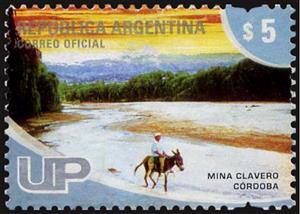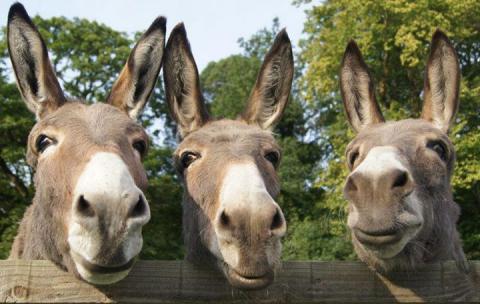Stamp: Mina Clavero, Cordoba (Argentina 2011)
Mina Clavero, Cordoba (Argentina 2011)
01 January (Argentina ) within release UP - Tourist Attractions goes into circulation Stamp Mina Clavero, Cordoba face value 5 Argentine peso
| Stamp Mina Clavero, Cordoba in catalogues | |
|---|---|
| Gz (Cefiloza): | Gz: AR 3125Ea |
Stamp is horizontal format.
Security mark at right. Thick letters. Under UV lamp: front neutral, back dark violet, Gum diagonally ribbed. Ordinary, laidAlso in the issue UP - Tourist Attractions:
- Stamp - Mina Clavero, Cordoba face value 5;
- Stamp - Buenos Aires face value 1;
- Stamp - Aconcagua, Mendoza face value 2;
- Stamp - Mina Clavero, Cordoba face value 5;
- Stamp - Ushuaia, Tierra del Fuego face value 10;
- Stamp - Buenos Aires face value 1;
- Stamp - Iruya, Salta face value 50;
- Stamp - Peninsula Valdes, Chubut face value 3;
- Stamp - Peninsula Valdes, Chubut face value 3;
- Stamp - Ruins of San Ignacio Mini, Misiones face value 25;
- Stamp - Ushuaia, Tierra del Fuego face value 10;
- Stamp - Ushuaia, Tierra del Fuego face value 10;
- Stamp - Buenos Aires face value 1;
- Stamp - Iruya, Salta face value 50;
- Stamp - Aconcagua, Mendoza face value 2;
- Stamp - Ruins of San Ignacio Mini, Misiones face value 25;
Stamp Mina Clavero, Cordoba it reflects the thematic directions:
Animals are multicellular, eukaryotic organisms of the kingdom Animalia (also called Metazoa). All animals are motile, meaning they can move spontaneously and independently, at some point in their lives. Their body plan eventually becomes fixed as they develop, although some undergo a process of metamorphosis later on in their lives. All animals are heterotrophs: they must ingest other organisms or their products for sustenance.
The donkey is a domesticated equine. It derives from the African wild ass, Equus africanus, and may be classified either as a subspecies thereof, Equus africanus asinus, or as a separate species, Equus asinus. It was domesticated in Africa some 5000–7000 years ago,and has been used mainly as a working animal since that time.
A landscape is the visible features of an area of land, its landforms and how they integrate with natural or man-made features. A landscape includes the physical elements of geophysically defined landforms such as (ice-capped) mountains, hills, water bodies such as rivers, lakes, ponds and the sea, living elements of land cover including indigenous vegetation, human elements including different forms of land use, buildings and structures, and transitory elements such as lighting and weather conditions. Combining both their physical origins and the cultural overlay of human presence, often created over millennia, landscapes reflect a living synthesis of people and place that is vital to local and national identity. The character of a landscape helps define the self-image of the people who inhabit it and a sense of place that differentiates one region from other regions. It is the dynamic backdrop to people’s lives. Landscape can be as varied as farmland, a landscape park, or wilderness. The earth has a vast range of landscapes, including the icy landscapes of polar regions, mountainous landscapes, vast arid desert landscapes, islands and coastal landscapes, densely forested or wooded landscapes including past boreal forests and tropical rainforests, and agricultural landscapes of temperate and tropical regions.
Mammals are any vertebrates within the class Mammalia (/məˈmeɪli.ə/ from Latin mamma "breast"), a clade of endothermic amniotes distinguished from reptiles (including birds) by the possession of a neocortex (a region of the brain), hair, three middle ear bones and mammary glands. All female mammals nurse their young with milk, secreted from the mammary glands. Mammals include the largest animals on the planet, the great whales. The basic body type is a terrestrial quadruped, but some mammals are adapted for life at sea, in the air, in trees, underground or on two legs. The largest group of mammals, the placentals, have a placenta, which enables the feeding of the fetus during gestation. Mammals range in size from the 30–40 mm (1.2–1.6 in) bumblebee bat to the 30-meter (98 ft) blue whale. With the exception of the five species of monotreme (egg-laying mammals), all modern mammals give birth to live young. Most mammals, including the six most species-rich orders, belong to the placental group. The largest orders are the rodents, bats and Soricomorpha (shrews and allies). The next three biggest orders, depending on the biological classification scheme used, are the Primates (apes and monkeys), the Cetartiodactyla (whales and even-toed ungulates), and the Carnivora (cats, dogs, seals, and allies).
A river is a natural freshwater stream that flows on land or inside caves towards another body of water at a lower elevation, such as an ocean, lake, or another river. A river may run dry before reaching the end of its course if it runs out of water, or only flow during certain seasons. Rivers are regulated by the water cycle, the processes by which water moves around the Earth. Water first enters rivers through precipitation, whether from rainfall, the runoff of water down a slope, the melting of glaciers or snow, or seepage from aquifers beneath the surface of the Earth.
Tourism is travel for pleasure or business; also the theory and practice of touring, the business of attracting, accommodating, and entertaining tourists, and the business of operating tours. Tourism may be international, or within the traveller's country. The World Tourism Organization defines tourism more generally, in terms which go "beyond the common perception of tourism as being limited to holiday activity only", as people "traveling to and staying in places outside their usual environment for not more than one consecutive year for leisure, business and other purposes". Tourism can be domestic or international, and international tourism has both incoming and outgoing implications on a country's balance of payments. Today, tourism is a major source of income for many countries, and affects the economy of both the source and host countries, in some cases being of vital importance.






